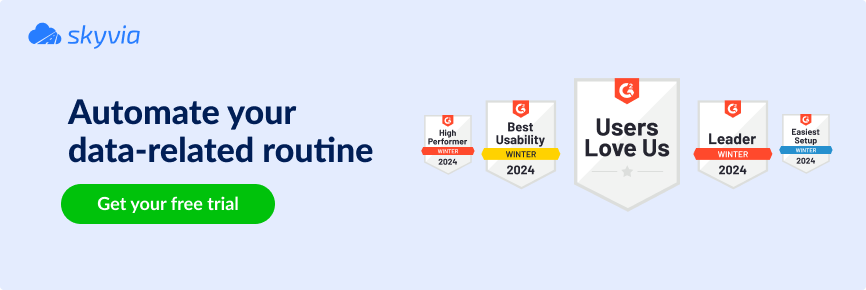Our reality is flooded with data. However, raw data, in its original form, is often messy and unstructured. Without processing, making sense of or using it meaningfully is hard.
This article considers various data processing tool types, their benefits, and their impact on business processes and decision-making.
Table of Contents
- What is Data Processing?
- Data Processing Types
- Stages in Processing Data
- Types of Data Processing Tools
- Essential Features of Data Processing Tools
- Top 5 Data Processing Tools in the Market for 2025
- Future Trends in Data Processing
- Final Thoughts
What is Data Processing?
Data processing transforms raw, unorganized data into clear, actionable insights that help businesses make informed decisions. Whether it’s as simple as sorting a list or as complex as analyzing huge datasets, data processing is the key to unlocking the actual value of data.
Let’s see this story in numbers:
- A study by McKinsey found that companies that leverage customer behavioral insights (a product of effective data processing) outperform peers by 85% in sales growth and more than 25% in gross margin.
- Research from Forrester suggests that 58% of businesses rely on data processing tools to make more accurate and data-driven decisions, leading to an average increase in productivity by 33%.
- According to a report by IBM, the cost of poor data quality in the US alone is estimated at $3.1 trillion annually. Effective data processing can significantly reduce these costs by ensuring data accuracy and reliability.
- The global data processing and analytics market was valued at $31.8 billion in 2021 and is expected to reach $76.7 billion by 2026, according to MarketsandMarkets. This growth underscores the increasing reliance on data processing for business success.
Data Processing Types
Data processing usually depends on specific needs and the nature of data. The three primary types of data processing are:
- Batch
- Real-Time
- Distributed
Each type has its unique approach and is suited to different tasks. Here’s a quick overview of these data processing types.
| Data Processing Type | Definition | Quick Summary |
|---|---|---|
Batch Processing | Involves collecting data over a period of time and processing it all at once. This method is ideal for tasks that don’t require immediate action, like payroll processing or generating monthly reports. | Best for periodic data handling. |
| Real-Time Processing | Data is processed immediately as it is collected, allowing for instant feedback and actions. This method is used in scenarios where time-sensitive data is crucial, such as online transactions, stock trading, or monitoring systems. | Essential for instant decision-making. |
| Distributed Processing | Involves processing data across multiple servers or machines simultaneously. This approach handles large datasets that require significant computational power, often seen in big data analytics and complex scientific computations. | Key for managing large-scale data tasks efficiently. |
Stages in Processing Data
Not depending on the type, each data processing consists of a few crucial stages that work together to turn raw data into valuable insights, guiding better decision-making and helping organizations understand their data in meaningful ways:
- Data Collection.
- Data Cleaning.
- Data Transformation.
- Data Analysis.
- Data Visualization.
- Data Collection. This stage is the first one in the data processing journey. Imagine this as gathering all the ingredients to cook a meal. Data collection involves gathering raw data from databases, IoT, online surveys, or social media. The goal is to merge all the data users need to make sense of it.
- Data Cleaning. The quality and relevance of the data collected are crucial because they set the foundation for the entire process. Once users have collected the data, it’s time to clean it up, like washing and prepping the ingredients before cooking. This step is vital because raw data is often messy and unstructured. Clean data ensures that the analysis companies perform later on is accurate and reliable. Data cleaning involves:
- Identifying and correcting errors.
- Removing duplicates.
- Filling in missing values.
- Data Transformation. After the data is clean, it might still need a little tweaking to be usable, just like chopping veggies or marinating meat. Data transformation involves converting the data into a format or structure suitable for analysis. It can include normalizing data, aggregating information, or converting data types. The aim is to get the data into a consistent, standardized form to be easily analyzed.
- Data Analysis. This stage involves turning raw data into actionable insights to inform decisions, solve problems, or uncover opportunities. It’s where users start to dig into the data to uncover patterns, relationships, and insights. Depending on the goals, this could involve:
- Statistical analysis.
- Machine learning models.
- Looking at trends over time.
- Data Visualization. Finally, it’s time to serve the dish and show it off. Data visualization presents the findings in a clear, visual format, like charts, graphs, dashboards, or interactive reports. Good visualization helps make complex data more understandable and accessible to everyone, not depending on the users’ expertise level. This stage is crucial because it turns the insights into a story others can easily grasp and act on.
Types of Data Processing Tools
Data processing tools are essential for transforming raw data into valuable insights. Different tools can be used to handle various aspects of data processing. These tools can be categorized into their functionality and use cases. Each type has its unique features, benefits, and examples. Let’s walk through such tool types.
| Functionality and Use Case | Description | Examples |
|---|---|---|
Extract, Transform, Load (ETL) Tools | ETL tools are designed to extract data from multiple sources, transform it into a format that’s compatible with the destination system, and then load it into that system. These tools are essential for data warehousing, data migration, and business intelligence tasks. ETL tools work well with structured data, preparing it for analysis or reporting. | – Skyvia. A cloud-based tool for no-code ETL operations, enabling data migration and synchronization between platforms like Salesforce, Google Sheets, and databases. – Informatica PowerCenter. A market-leading ETL platform known for its powerful data transformation and integration capabilities. – Talend. Open-source ETL tool with a strong emphasis on data integration and transformation, often used in complex data workflows and migration tasks. |
Streaming and Event-Driven Tools | Streaming and event-driven tools process data continuously, handling real-time data as it’s generated. These tools are essential for scenarios that require immediate analysis and action, such as detecting fraud, monitoring IoT devices, or customer engagement. They are designed to process and respond to events or data streams as they happen. | – Apache Kafka. A popular platform for building real-time streaming applications. Kafka processes massive streams of data in real time, perfect for event-driven use cases. – Google BigQuery. Offers real-time analytics on large-scale datasets, often used in conjunction with streaming data pipelines. – Amazon Kinesis. A fully managed service for real-time data streaming, enabling real-time analytics for IoT devices, logs, and machine learning. |
Essential Features of Data Processing Tools
Picking out the perfect data processing tool is like choosing the right kitchen gadgets. We always want something fast, reliable, and easy to use, but it must also handle whatever we cook: a quick weeknight dinner or a multi-course feast. In the kitchen, like in data processing, certain features can make or break the workflow, determining how smoothly everything runs, how much users can whip up, and how safe their data stays.
Here are the key features to look out for:
- Speed and Efficiency.
- Scalability.
- Security Features.
- User Interface and Experience.
- Speed and Efficiency. Nobody likes a slow cooker when you’re starving for insights. The speed and efficiency of a data processing tool are crucial. Users want a tool that can handle large volumes of data quickly, whether they’re processing real-time transactions or simmering complex queries on a massive dataset. A fast tool means the business gets the insights served hot and fresh, perfect for making those timely decisions.
- Scalability. It means preparing for growth. As the business grows, so does the data, which needs a tool to scale with the company. Whether the organization is dealing with small datasets today or planning to process terabytes of data tomorrow, the right tool should be able to expand its capacity without breaking a sweat.
- Security Features. Data is valuable, and keeping it safe is non-negotiable. Security features in a data processing tool are like your secret family recipe. They protect you from potential risks. Whether it’s encryption, user authentication, or secure data storage, these features ensure that the data is handled safely and stays out of the wrong hands. In today’s world, where data breaches are common, strong security is a must-have.
- User Interface and Experience. Last but not least, the user interface (UI) and experience (UX) can make or break the relationship with a data processing tool. A tool with an intuitive, user-friendly interface makes it easy to navigate through the data, run processes, and generate reports without needing a manual every time. It’s like having a kitchen with perfectly organized drawers and tools where you expect smooth cooking.
Top 5 Data Processing Tools in the Market for 2025
Skyvia
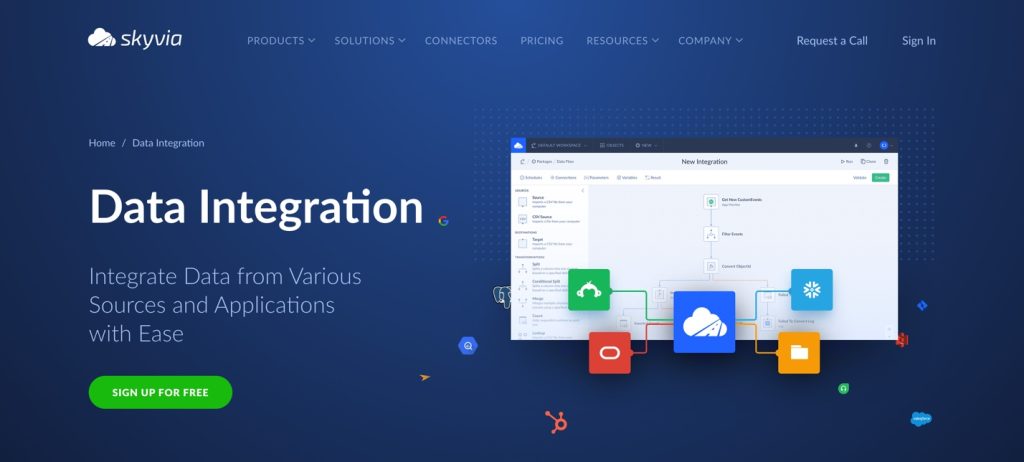
Skyvia is a universal cloud-based platform that provides ETL, ELT, and reverse ETL data integration, backup, and data sync. It’s well-suited for businesses that need to move data between cloud services, synchronize data between systems, or create complex ETL workflows without extensive coding. Skyvia supports 190+ data sources, including popular cloud apps like Salesforce, Google Sheets, and SQL databases, making it a flexible and powerful tool for cloud-based data processing.
Key Features
- Intuitive drag-and-drop interface for building data pipelines.
- The solution offers data integration, backup, and synchronization in a single platform.
- No-coding ETL process, making it accessible to non-developers.
- The platform is super user-friendly. According to the G2 Crowd rate, it’s in the top three of the easiest-to-use ETL tools.
Key Challenges
- Needs more video tutorials to describe the key features.
Pricing
- Paid plans start at $79/month, with more advanced features available at higher tiers.
- Free tier available with limited features.
Informatica PowerCenter

Informatica PowerCenter is an enterprise-grade data integration platform that excels in transforming and moving large volumes of data across various systems. Known for its robust ETL capabilities, it’s a go-to solution for organizations with complex data processing needs requiring high reliability, scalability, and data governance.
Key Features
- Comprehensive ETL tool with strong data transformation capabilities.
- High scalability, suitable for processing large volumes of data.
- Extensive connectivity options with various databases, applications, and mainframes.
- Advanced data governance and metadata management features.
Key Challenges
- The steep learning curve.
- High cost, making it less suitable for small to medium-sized businesses.
Pricing
- Pricing is available upon request and typically varies based on deployment size and features.
Talend
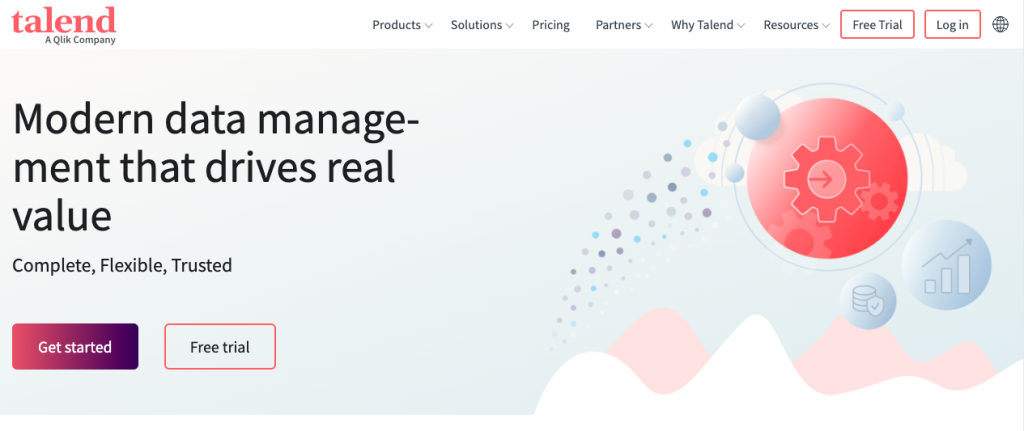
Talend is a popular data integration platform that provides a comprehensive suite of tools for data management, including ETL, data quality, and big data processing. Its open-source roots give it a flexible and community-driven edge, making it an excellent choice for organizations that need customizable solutions and value a collaborative environment.
Key Features
- The platform offers a robust open-source version that can be customized extensively, with a large community for support and development.
- It includes built-in tools for ensuring data accuracy and consistency, which is crucial for reliable analytics and reporting.
- It integrates with big data platforms like Hadoop and Spark, making it suitable for processing large datasets.
Key Challenges
- Performance can be an issue with extremely large datasets.
- Some advanced features require the paid version.
Pricing
- The free, open-source version is available.
- Talend Data Fabric (paid version) pricing starts at approximately $1,170 per user/month.
Apache Hadoop
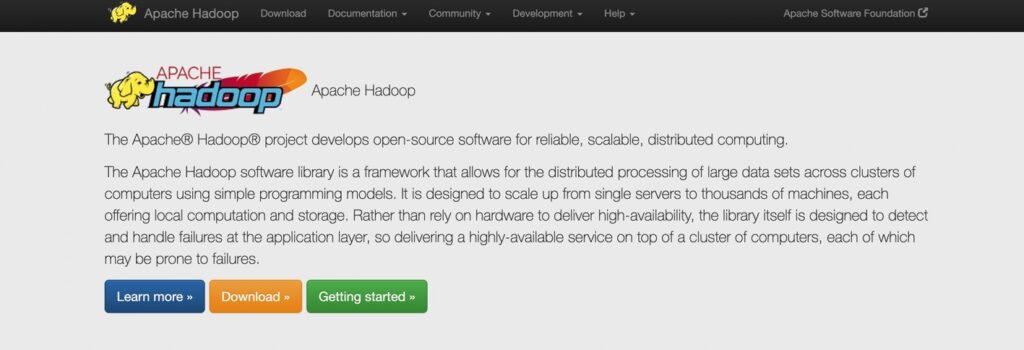
Apache Hadoop is an open-source framework that allows for the distributed processing of large datasets across clusters of computers. It’s a cornerstone of big data processing, offering scalability, fault tolerance, and the ability to handle vast amounts of unstructured data. Hadoop is perfect for organizations that need to efficiently store and process large-scale data.
Key Features
- Handles large volumes of structured and unstructured data.
- Distributed processing across multiple nodes, ensuring scalability.
- A strong ecosystem with tools like HDFS (Hadoop Distributed File System) and YARN.
- High fault tolerance, with automatic data replication and recovery.
Key Challenges
- Complex setup and management require significant expertise.
- Performance can vary depending on the configuration and hardware.
Pricing
- Hadoop itself is free and open-source, but costs can arise from the hardware, storage, and expertise required to manage it.
Google BigQuery
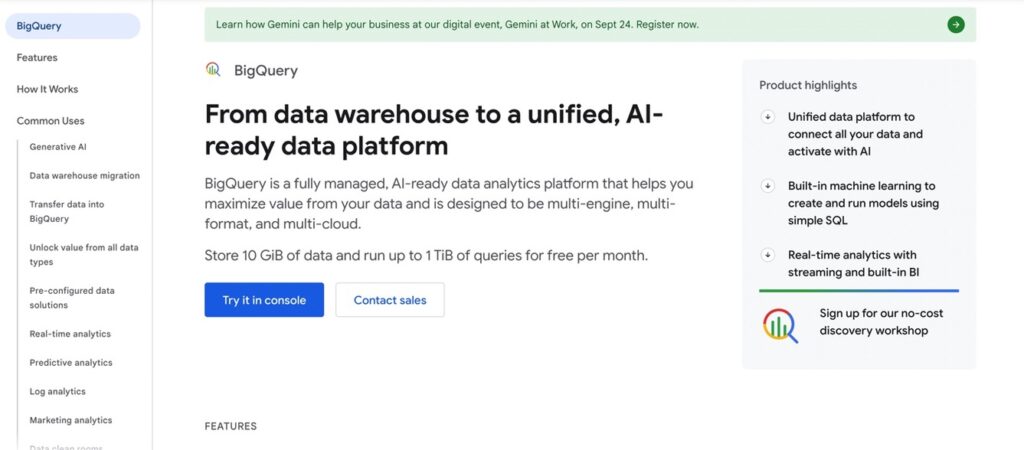
Google BigQuery is a fully managed, serverless data warehouse for fast SQL queries and real-time analytics on large datasets. As part of the Google Cloud Platform, it integrates seamlessly with other Google services, making it a powerful option for organizations looking to process and analyze big data without worrying about infrastructure management.
Key Features
- Serverless architecture with automatic scaling.
- Ability to run fast SQL queries on massive datasets.
- Real-time data analysis and integration with Google Cloud services.
- Built-in machine learning capabilities.
Key Challenges
- Cost can accumulate quickly with large amounts of data or frequent queries.
- Some users may find the pricing model (based on data processed) challenging to predict.
Pricing
- Pricing is based on a pay-as-you-go model, with storage starting at $0.02 per GB/month.
Future Trends in Data Processing
The future of data processing is dynamic and full of promise, with trends like real-time processing, AI integration, edge computing, and heightened security leading the way. Let’s consider these trends in more detail.
Real-Time Data Processing Becomes the Norm
Waiting for data to be processed in the future will feel as outdated as waiting for dial-up internet to connect. Real-time data processing, where data is analyzed and acted upon the moment it’s generated, is quickly becoming the standard. This shift is driven by the growing need for instant insights in finance, healthcare, and e-commerce, where decisions must be made in the blink of an eye.
Rise of AI and Machine Learning Integration
AI and machine learning are becoming the secret sauce in data processing. Almost every tool or service offers AI in its products. Therefore, we will see an even more significant development of such technologies in the future. As these technologies advance, they integrate into data processing tools to:
- automate complex tasks,
- predict trends,
- uncover insights that would be impossible to find manually.
In the future, we expect AI to play a more significant role in optimizing data workflows, personalizing user experiences, and driving innovation.
Edge Computing Gains Momentum
With the explosion of IoT devices and the need to process data closer to its source, edge computing is gaining momentum. Instead of sending data to a centralized cloud server for processing, edge computing allows data to be processed on-site, at the “edge” of the network. This approach reduces latency and speeds up decision-making, which is crucial in scenarios like autonomous vehicles, smart cities, and industrial automation.
Increased Focus on Data Privacy and Security
As data breaches and privacy concerns continue to make headlines, the future of data processing will see a greater emphasis on data security and compliance. Stricter regulations like GDPR and CCPA are just the beginning. Companies must adopt more advanced encryption techniques and privacy-preserving technologies like differential privacy and robust access controls to protect sensitive data.
Growth of Data-as-a-Service (DaaS)
The concept of Data-as-a-Service (DaaS) is set to take off, offering businesses access to data processing and analytics abilities on-demand without the need to manage the underlying infrastructure. This trend will make advanced data processing more accessible to companies of all sizes, enabling them to use big data, AI, and machine learning without the overhead of setting up complex systems.
Data Processing with Sustainability in Mind
Sustainability is becoming a key consideration across all industries, including data processing. As data centers and processing workloads grow, so does their environmental impact. The future will shift towards greener data processing practices, like using renewable energy sources, more efficient algorithms, and cooling technologies that reduce carbon footprints.
Final Thoughts
To summarize, data processing tools are essential for transforming raw data into ideas that really work, and their selection depends on different business needs, the company size, users’ skills, and the way of working with data. Whether you’re looking for a user-friendly cloud solution like Skyvia, an enterprise powerhouse like Informatica PowerCenter, or an open-source framework like Apache Hadoop, these tools offer a range of abilities to help businesses process and analyze their data effectively in 2024.
FAQ for Data Processing Tools
How do I choose the best data processing tool for my business?
When selecting a data processing tool, consider the following factors:
Ease of use: Does the tool have an intuitive interface?
Integration: Can it seamlessly integrate with your existing data sources and systems?
Scalability: Will it grow with your business as your data needs expand?
Cost: Is it within your budget, and does it provide value for the features offered?
Support and community: Does it have robust customer support and an active user community for troubleshooting and improvements?
What are the benefits of cloud-based data processing tools?
Cloud-based data processing tools, like Google BigQuery or Skyvia, offer several benefits:
Scalability: They can handle growing data volumes without needing expensive on-premise infrastructure.
Accessibility: Teams can access data from anywhere with an internet connection.
Cost-efficiency: You only pay for the resources you use, which is often cheaper than maintaining on-premise systems.
Automatic updates: Cloud services often provide regular updates and maintenance, reducing the need for manual intervention.
Can data processing tools handle real-time data?
Many modern data processing tools, such as Apache Kafka and Google BigQuery, are designed to handle real-time data processing. These tools allow businesses to collect, process, and analyze data as it is generated, essential for use cases like fraud detection, stock market analysis, and IoT (Internet of Things) applications.

